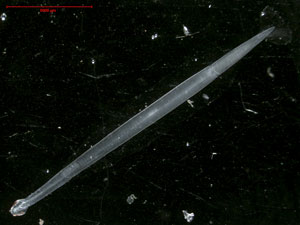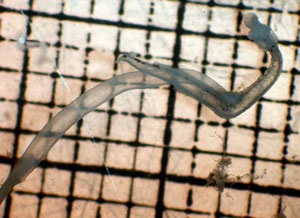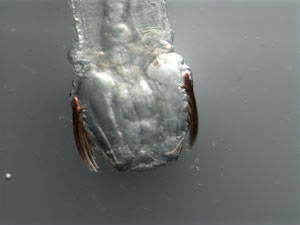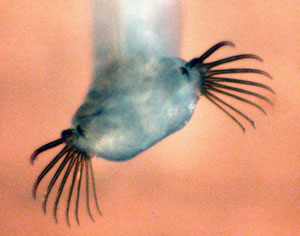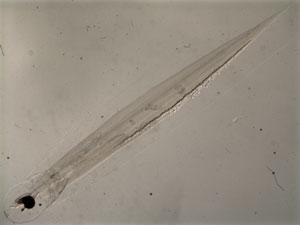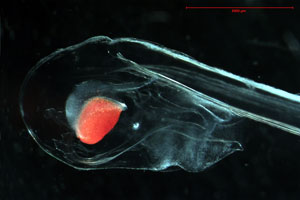Helen Drost, IOSAugust 26, 2007The zooplankton dispatch last year focused on the eye catching butterflies of the sea. This year it is time to introduce two worm-like creatures found in the nets that we deploy throughout the Canada Basin. The arrow worm (chaetognath) is often the most abundant group of the non-copepod fraction. This predator is known to be a voracious eater of copepods and any other readily available zooplankton including fish larvae. One species, Eukrohnia hamata, can comprise up to 18% of the biomass in the deep Canadian Basin. When looking at these worms under the microscope it is a relief to know they rarely reach more than 15mm in length! Chaetognaths appear to be structurally simple yet they can have a long life span (2 years) and are able to produce a toxin that anaesthetizes their prey before ingestion. Arrow worms are very sensitive to temperature and salinity gradients. Different species tolerate different conditions thus the change in species can act as an indicator of specific water masses. This indicator status has raised their profile in recent years. The other worm-like creature found here in the Arctic is actually a larvacean called Oikopleura vanhoeffeni. Past studies in the Canada Basin show that they are can be found in abundance up to 1200 m in depth. Unlike the arrow worms, these filter feeders have notochords and have a short generation time of approximately 20 days. They form delicate mucous houses, 4 to 10 times the size of the body, which protects and provides buoyancy to the animal. Constant tail movement creates a current of water that transports food directly into their homes. The houses get clogged up quickly and Oikopleura vanhoeffeni can make up to 10 new ones a day! The discarded houses are significant carbon traps that can reach densities of more than 1000 m-3. They sink to the sea floor and are part of what Rachel Carson describes in her book The Sea Around Us as "the steady, unremitting, downward drift of materials from above, flake upon flake, layer upon layer – a drift that has continued for hundreds of millions of years, that will go on for as long as there are seas and continents…the most stupendous snowfall the earth has ever seen." The two Arctic species described above are almost transparent to the naked eye and are, perhaps to some people, a bit creepy when viewed under a microscope. However, they should not be overlooked nor their impact underestimated.
Last updated: October 7, 2019 | ||||||||||||||||||||||||||||||||
Copyright ©2007 Woods Hole Oceanographic Institution, All Rights Reserved, Privacy Policy. | ||||||||||||||||||||||||||||||||


